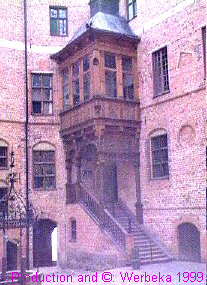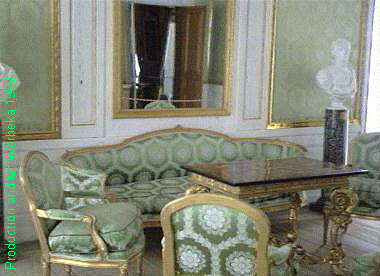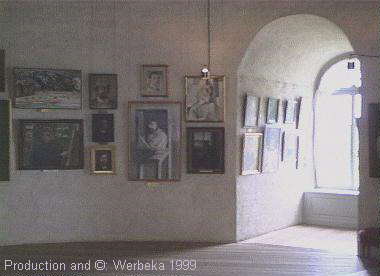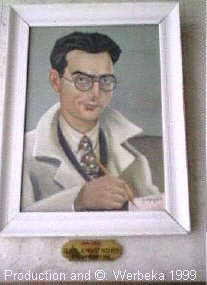 THE CASTLE OF GRIPSHOLM
THE CASTLE OF GRIPSHOLM
© Bernhard Kauntz, 1999
 |
View from the coastline of Mariefred
The castle of Gripsholm is one of ten Royal castles in Sweden. It is situated near the town of Mariefred in Södermanland, about 100 km to the southeast of Västerås. Its oldest parts derive from the 1540's, but the castle has been rebuilt and enlarged on several occations. Since 1822 it is the home of the Swedish National Portrait-collection, which today counts over 4000 pictures. |
| The entrance to the castle from the yard
I have always been fascinated by the overall form of the castle, with its round towers, which make it so characteristic - but to get the best view of it, you'll have to enter the town of Mariefred and take a look across the water.
In spite of my aversion of entrance-fees into cultural sites, I find the 50 Swedish crowns (about 6 Euro) in this case very well spent. It is a pity though, that children have to pay half the price. This building, if any, is a lesson of history of the very best sort and because of that it should not in any way diminuish our youth's need of knowledge, or even make them think of comparing the cost of knowledge with the price of an ice-cream. |
 |
| One of the many rooms, in which memory drowns
Immediately on entering, where the crowd swarms the cashier's desk, you find one of Ehrenstrahl's giant paintings of one of the horses of Karl XI. While this for sure is not what we expect of a portrait, the fact that Swedish portrait-painting more ore less starts with the works of this man, it is an "excuse" as good as any, to let him start the show.
The biggest difficulty in Gripsholm is that you must be able to concentrate on two, or better still on three different things at the same time. The castle itself is of course interesting, that is how and who was living there throughout the years, its furniture, its adornment and so on. On the other hand, the portraits, the main attraction, call for your undivided attention and thirdly the artists behind the paintings would be worth to notice as well. Finally, most of the pictures give you some reason for a historical detour, which makes the strain on your mind even more complicated. |
 |
| The clock in the residence of the Princess is already two centuries old
There is some overall help, though. All the rooms are numbered and the exhibition of rooms and paintings follows more or less a chronological order. On the entrance-level you find mainly paintings from the 16th and 17th century (from Gustav Vasa to Karl XII) and these rooms are presented more or less in the fashion they could have had at that time. Logically enough there is not much left of the furniture, but you can still see what the walls looked like, or the floors and ceilings.
On the next floor there is Rikssalen (the Chamber of the State), the biggest room in the castle. The large paintings show European monarchs, who were Gustav Vasa's contemporaries.
|
 |
 |
The Green Chamber in the Queen's residence
The rest of the second floor is mainly furnished with pieces from the 18th century, not at least because most of the space on this floor was part of the residence of King Gustav III and his spouse Sofia Magdalena. Some other rooms were part of the residence of the Princess, Sofia Albertina, the sister of the King. The furniture here consists indeed of high class, whether it is a chest of some kind made by Haupt or Hultsten, or the original silken tapestry from China or mirrors Made by Meunier.
|
The paintings, most of them from the 18th century as well, invite you to follow up sidelines of history, because the portraits from this era not only show persons from the political scene, but also show writers, scientists and others.
In the King's White Chamber on the other hand, there are only pictures of European potentates again, this time contemporary with Gustav III. Among Friedrich II from Prussia, Katerina II from Russia, Georg III from England and Ludvig XV from France, I find my own countrymen, Maria Theresia and Joseph II from Austria. The large portraits between the enormous window-bays in this expensively furnished room leave a long-lasting impression.
|
 |
One of many guest chambers on the third floor
This impression is still largely overshadowed by the theater of Gustav III, which you find, following the staircase upwards. It is hard to describe this room, nor could even a photo do justice to this precious creation. I am as much fascinated of the possibilities of using daylight to bring natural light onto the scene, as I am of the Greek columns, which lead the mind back to the origin of play-writing.
|
| A part of the corridor
The rest of the third floor consists of less important rooms, many of them used as guest rooms, furnished often with pieces which were left over in other places. During the restauration in the 1890's some of the guest rooms, established by Gustav III, were moved from the outer part of the floor to the inner, overlooking the yard. This was done in order to build a corridor for the watchmen, running along the inside of all four walls of the castle. Following the direction of the sun's movement you find portraits from the 19th century to start with, more or less in chronological order. At the time of this restauration, the large gallery was formed, which occupies all the space of one wall on the third floor. It is used to show large group-portraits from the late 17th century to our days.
|
 |
 |
And there are paintings everywhere
Following the corridor clockwise you will finally find the three chambers, in which Duke Fredrik Adolf was living. The portraits on the walls show now works from the 20th century. And it has become almost impossible to keep an overview, because there have been too many impressions for one visit only.... The styles of painting have become more diversified, for good or for bad.
|
| A self-portrait
Yes, there are many good works of art among the pictures of our time, here is one I like, even if I have forgotten the artist's name. But there are as well many paintings, which time will pick off, and which coming generations won't be missing. The interesting thing about art, as well as literature and music, is that they are purifying themselves, the survival of the best only. Sorrowfully this means often that the originators of these works are not recognized during their lifetime, when it is more usual that those who are good at selling themselves capture all the honour. This depends lastly on the fact that the market - the customer - is ignorant. That is why it is so important that there are places like Gripsholm and that they are open to everyone.
|
 |
| One of the latest additions
Using the main staircase you come down to the entrance floor, where there are paintings showing foreigners, but where you also can find well-known persons who are our own contemporaries. Some of the political party-leaders are shown, Olof Palme being one of the latest, but I remember the soccer-player Gunnar Nordahl and some entertainers as well.
It was a wonderful time, the hours which have passed during my stay in the castle, I can only recommend a visit, or even a couple of them. And on leaving the castle through the reception, the Royal Family on a large group-portrait waves a cordial "Welcome back" to you.
|
 |
Back to the  , the , the  or to the
or to the  of of 
last update: 21.7.1999 by
webmaster@werbeka.com
|

 , the
, the  or to the
or to the  of
of 

 , the
, the  or to the
or to the  of
of 